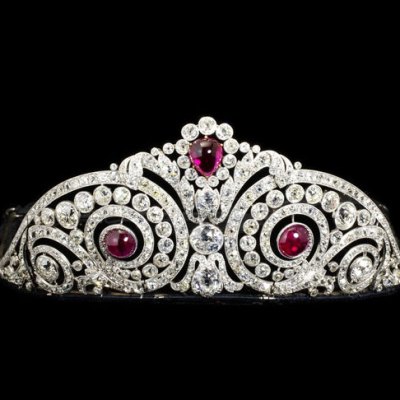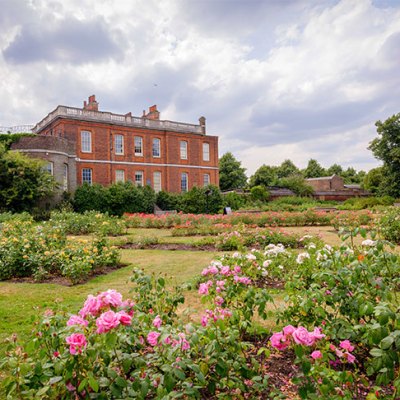It is a full half-century since the dawn of serious and scholarly interest in the architecture and artefacts of the Aesthetic and Arts and Crafts Movements, and time is ripe for a reassessment of their place, not as isolated phenomena, but in the wider development of 19th- and 20th-century aesthetics. The Fitzwilliam Museum’s ‘Designers and Jewellery 1850–1940’, an exhibition of 70 objects from the museum’s permanent collection, or on long-term loan, presents the sweep of design in jewellery and metalwork from Gothic Revival to 1930s moderne.
Brooch in the shape of a ram’s head (c. 1860–70), made by Castellani. Fitzwilliam Museum, Cambridge

The transition from Gallery VIII of the Fitzwilliam, with its crimson walls, Van Dyck portraits and plethora of Rubens bozzetti, into the dark ultramarine blue of the Octagon Gallery is dramatic, requiring instant ocular adjustment. For this exhibition the Octagon has been transformed into a spacious jewel cabinet into which the visitor steps to immerse him- or herself in a rich variety of objects ranging from the robust to extremes of delicacy and finesse. Facing one on entry are four free-standing cases containing the larger objects, mainly by Gilbert Marks, C.R. Ashbee and the Guild of Handicraft, while 18 wall-display cases, lined with the same ultramarine material as the walls, lead the visitor clockwise and chronologically from Castellani’s delicate ram’s head brooch of the 1860s to Sibyl Dunlop’s chunky pendant cross of around 1930.
The exhibits, broadly speaking, are British, though in the earlier part of the display there is a liberal sprinkling of Italian names, particularly those of the various members of the Castellani and Giuliano families. From the time of the Great Exhibition through the 1860s Britain remained the commercial centre of Europe, while Italy was in a state of political turmoil, forcing the more politically involved, such as Alessandro Castellani, into exile.
Pendant cross (c. 1930), designed by Sibyl Dunlop and made in her workshop, probably by W. Nathanson, with enamelling by Henri de Koningh. Fitzwilliam Museum, Cambridge

He used this opportunity to set up branches of the family firm in both Paris and London; the latter in conjunction with Carlo Giuliano. Happily, Helen Ritchie’s scholarly text in the large, fully illustrated catalogue, guides us through the intricacies of these family connections and the many links between the various firms. She describes how ‘For seventeen years he [Carlo Giuliano] created pieces for the West End trade and for other retailing jewellers, including C.F. Hancock of Bond Street, Hunt & Roskell and Phillips before eventually opening his own retail premises at 115 Piccadilly, where he was listed as art jeweller, goldsmith, silversmith and diamond merchant.’
Sabbatai ring (1904), designed by Charles de Sousy Ricketts, probably made by Carlo & Arthur Giuliano. Fitzwilliam Museum, Cambridge

Several decades later we find Charles Ricketts making his way to 115 Piccadilly to consult Giuliano’s sons – Carlo Joseph and Arthur Alphonse – concerning the making of several pieces of jewellery he had designed for Katherine Bradley and Edith Cooper. The two women – aunt and niece – wrote poetry and plays together and were known jointly by the male pseudonym Michael Field. One of the outstanding pieces in the exhibition is a gold and sapphire Sabbatai ring that Ricketts designed for ‘Michael’/Bradley, and Edmund Dulac’s glorious icon-like painting Charles Ricketts and Charles Shannon as Medieval Saints (1920) hangs nearby.
Looking at the list of individual designers and designer-makers, as opposed to the various firms and partnerships (Watherston & Brogden, Hunt & Roskell, Carlo & Arthur Giuliano, Child & Child), it is interesting to note that nearly half of them were architects or had had architectural training – C.R. Ashbee, William Burges, John Paul Cooper, Archibald Knox, Edward Spencer, C.F.A. Voysey, William White and Henry Wilson; even Harry Murphy, by association through his training in Wilson’s studio, was brought into contact with the great Arts and Crafts architectural legacy of Sedding and Street. Burges’s silver-mounted glass decanter, lavishly encrusted with agates, amethyst and other semi-precious stones as well as ancient coins, is the first exhibit to greet the viewer. It was one of a pair, made for Burges’s own use, which came up at auction in 1968 when they sold for £1,800. They were bought by the Kensington dealer Richard Dennis and subsequently sold to those pioneer collectors Charles and Lavinia Handley-Read. In those days such objects were despised by the antiques and jewellery trade and even as late as 1975 when, with Charlotte Gere, we mounted an exhibition at the Fine Art Society, ‘Jewellery and Jewellery Design 1850–1930’, with an entire section of more than a hundred items by John Paul Cooper, including the silver and abalone shell buckle exhibited here, we were mocked by the grand Bond Street jewellery dealers. A few weeks ago a gold and gem-set pendant by Murphy, with a water sapphire cabochon, fetched over £70,000 at auction. How times have changed.
Decanter (1865–66), designed by William Burges with mounts made by George Angell and Josiah Mendelson. Fitzwilliam Museum, Cambridge

In addition to the Handley-Reads, Helen Ritchie pays tribute to other pioneer collectors, especially those who were benefactors of the Fitzwilliam Museum. Outstanding among these was the notoriously difficult Anne Hull Grundy. Ritchie describes her as being in many ways ‘the first collector to take jewellery seriously as another avenue of art history, and to study what it could tell us about the lives of those who made and wore it’. She was interested in pieces made from unusual materials such as cut steel, coral, jet and paste, and once quipped, ‘I prefer my paste to other people’s diamonds.’ Although there is enough silver and gold as well as gemstones in the exhibition to give glitter to the displays, many of the Arts and Crafts designers preferred using base metals – pewter, copper and even aluminium – and favoured non-precious stones such as garnets, carnelian and chalcedony as well as enamelling for decoration. Voysey chose sand-cast aluminium for his elegantly simple clock made in the late 1890s which, in its unornamented stylishness, is a precursor to Gleadowe and Murphy’s silver fluted vase, selected by Edward McKnight Kauffer as the dominant image for his poster of 1938 advertising the Exhibition of Modern Silverwork, at Goldsmiths’ Hall.
Among many other outstanding items are a gold floral brooch/hair ornament by Hunt & Roskell of around 1850, a silver necklace composed of double-spiral links by Phillips of around 1870, a silver morse set with a large cabochon amethyst and cabochon garnets by Carl Krall from the late 1890s, and one of C.R. Ashbee’s most ambitious creations, the Gardiner cup, made by the Guild of Handicraft in 1904–05 and named after the client for whom it was created.
Designers and Jewellery 1850–1940: Jewellery and Metalwork from the Fitzwilliam Museum is at the Fitzwilliam Museum, Cambridge until 11 November.
From the September issue of Apollo. Preview and subscribe here.



